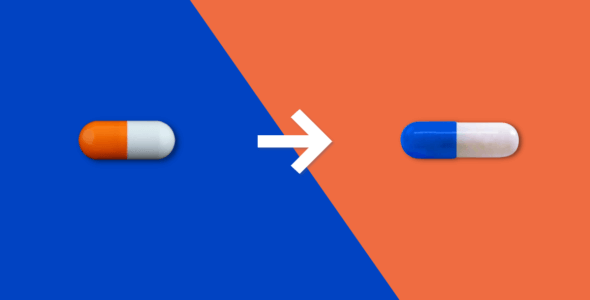Switching from Adderall to Concerta
Table of contents
- What is ADHD?
- What is Adderall?
- What is Concerta?
- How do Adderall XR and Concerta work in the body?
- When is it recommended to switch From Adderall to Concerta?
- How long does it take for Adderall XR to work?
- How long does it take for Concerta to work in the body?
- Forms and dosages of Adderall XR
- Forms and dosages of Concerta
- Adderall XR vs Concerta
- Adderall XR and Concerta side effects
- Non-stimulant options for treatment of ADHD
There are many types of ADHD medications that your doctor can prescribe including stimulants, non-stimulants, anti-depressants, blood pressure medications, and anticonvulsants. Clearly, there are many treatment options available and it can be puzzling when you are looking to change medication.
Stimulant meds are widely used and Adderall is one of the most well-known brand name drugs used to treat ADHD. Perhaps Adderall isn’t working well for you and your doctor has suggested trying Concerta but you are reluctant to start a new medication. This blog will take a look at how Adderall XR compares to Concerta so you are more informed when talking to your healthcare provider.
What is ADHD?
ADHD is the abbreviation of Attention Deficit Hyperactivity Disorder characterized by inattention, hyperactivity, and impulsivity. It is a neurodevelopmental disorder that is typically diagnosed in childhood, commonly in males but underdiagnosed in females. According to the Centers for Disease Control and Prevention, there are an estimated 6.4 million children and adolescents diagnosed with ADHD in the United States.
Mental health professionals have identified three types of ADHD, based on the main symptoms involved:
- Inattentive type ADHD
- Hyperactive-impulsive ADHD
- Combination of inattentive and hyperactive-impulsive type ADHD
ADHD symptoms can vary from person to person, depending on the subtype of ADHD.
Inattentive type
Symptoms of inattention:
- Disorganization
- Struggle to pay close attention to details, which may result in frequent mistakes
- Often does not follow through on instructions
- Appear to not listen
- Can get frustrated performing tasks or activities requiring mental effort
- Distractibility
- Misplace items
- Careless mistakes
- Forgetfulness
- Daydreaming
Hyperactive/impulsive type
Symptoms of hyperactivity:
- Behavior problems
- Impulsive behaviors
- Fidgeting with hands and feet or squirming
- Trouble staying seated
- Difficulty playing or doing leisure activities quietly
- Excessive talkativeness, including interrupting in conversation
- Difficulty waiting
- Interrupt or intrude on others
Combination-type ADHD
The combined type of ADHD shows a mixture of inattentive and hyperactive/impulsive type symptoms and behaviors.
ADHD medication can reduce the troublesome symptoms of ADHD shown above. It is not an easy task to find the best ADHD medication. There are many factors that your doctor will consider when selecting a patient, including their history and genetics as well as the side effects they have experienced with other treatments or substances.
What is Adderall?
Adderall contains mixed amphetamine salts and is available in two formulations: Adderall IR (immediate-release) is short-acting and Adderall XR (extended-release) is long-acting. We will focus on Adderall XR in this blog as Concerta is an extended-release product only.
Adderall contains four different kinds of amphetamine salts – amphetamine sulfate, amphetamine aspartate, dextroamphetamine saccharate, and dextroamphetamine sulfate. It is a Schedule II controlled substance
Adderall XR is indicated for the treatment of:
- Attention Deficit Hyperactivity Disorder (ADHD) in adults and children 6 years of age and older
What is Concerta?
Concerta is indicated for the treatment of:
- Attention Deficit Hyperactivity Disorder (ADHD) in children 6 years of age and older, adolescents, and adults up to the age of 65
Concerta treats the symptoms of ADHD such as inattention, poor decision making, and poor impulse control. It can also be used for the treatment of narcolepsy.
Concerta is the brand name of an extended-release form of methylphenidate. Methylphenidate is a central nervous system (CNS) stimulant that is classed as a Schedule II controlled substance. It is a long-acting stimulant, therefore you only need to take Concerta once daily for symptom relief.
Get your Concerta medication for only $49 per month
Get StartedHow do Adderall XR and Concerta work in the body?
Adderall and Concerta belong to a class of drugs known as amphetamines. By working on the central nervous system, Adderall and Vyvanse increase activity in areas of the brain that help you with your concentration and behavior. They work specifically on the chemicals dopamine and norepinephrine in the brain. These neurotransmitters, dopamine, in particular, are involved in feelings of pleasure, focus, and finding things interesting. Stimulant medications reduce the symptoms of ADHD making conditions such as inattention, poor decision making, and poor impulse control much less of a daily problem.
Other prescription drug stimulants that work in a similar way include Ritalin (methylphenidate) and Vyvanse (lisdexamfetamine).
When is it recommended to switch From Adderall to Concerta?
- When Adderall XR is not providing symptom control. It is possible your body may not be responding to the active ingredients in Adderall XR. Some people respond better to different stimulants and Concerta is another longer-acting stimulant to try. You need to find the drug that works best for you.
- When Adderall is not well tolerated
Stimulants are powerful medications that wear off rapidly. They’re also completely eliminated from your body by the end of their specified duration, so it’s possible to stop taking them one day and start another stimulant on another. Your doctor will tell you how this transition should be made when changing from Adderall XR to Concerta.
How long does it take for Adderall XR to work?
It will take Adderall XR around 30 minutes to 1 hour to start working in your body for a duration of 10-12 hours. Duration times are just approximate.
How long does it take for Concerta to work in the body?
Concerta starts working in about 1 hour of taking the dose. Then, the drug is gradually released over time for a duration of 10-12 hours. Duration times are just approximate.
Forms and dosages of Adderall XR
Adderall XR (extended-release) is taken as a daily dose. It is available in capsule form in the following doses: 5 mg, 10 mg, 15 mg, 20 mg, 25 mg, and 30 mg. It is taken with or without food in the morning. Adderall XR capsules can be opened and mixed with food if required.
Doctors will usually prescribe a lower dose when you first start taking a medication and gradually titrate it until they find the right therapeutic dose for you and your symptoms.
Forms and dosages of Concerta
Concerta (extended-release) is taken as a daily dose available in tablet form in the following doses: 18 mg, 27 mg, 36 mg, and 54 mg.
In order for Concerta to work effectively, it needs to be taken whole. The tablet can not be crushed or chewed. It can be taken with or without food.
Adderall XR vs Concerta
- Adderall XR contains four different kinds of amphetamine salts: amphetamine sulfate, amphetamine aspartate, dextroamphetamine saccharate, and dextroamphetamine sulfate. Concerta contains the active ingredient methylphenidate
- Concerta is only available as an extended-release tablet whereas Adderall XR is available as an extended-release and immediate-release formulation
- Concerta tablets can not be crushed or chewed due to their delivery system but Adderall XR capsules can be opened and added to food if needed
- Both drugs have similar adverse effects including loss of appetite, trouble sleeping, and weight loss
Adderall XR and Concerta side effects
The most common side effects of Adderall XR and Concerta in children, adolescents, and/or adults with ADHD are:
- Anorexia
- Anxiety
- Dizziness, nausea
- Blurred vision
- Dry mouth
- Irritability
- Insomnia
- Upper abdominal pain, stomach pain, vomiting, loss of appetite, decreased weight, diarrhea, constipation
- Motor tics (repeated muscle movements)
- Increased heart rate
In rare instances, Adderall XR and Concerta can cause more serious side effects. These can include:
- Serious cardiovascular reactions e.g. chest pain
- Sudden death has been reported with CNS stimulant treatment at recommended doses in pediatric patients with structural heart defects or other serious heart problems
- Sudden death, stroke, and heart attacks in adults
- High blood pressure and increased heart rate
- Suppression of growth – monitor height and weight in pediatric patients
- Circulation problems – symptoms include skin color changes and a cold feeling including Raynaud’s phenomenon
- Serotonin syndrome – an increased risk when co-administered with serotonergic agents (e.g., SSRIs, SNRIs, triptans), but also during overdosage situations
- New or worsening psychosis, bipolar disorder, or mental health issues
- Withdrawal symptoms if you suddenly stop using this medication – severe tiredness, sleep problems, mental/mood changes such as depression
- Severe allergic reactions e.g. hives, shortness of breath
Your doctor will assess the benefits of using Adderall XR and Concerta against your risk of side effects. You are encouraged to report negative side effects or adverse reactions of Adderall XR and Concerta to the FDA. Visit www.fda.gov/medwatch, or call 1-800-FDA-1088.
Controlled substances and dependence
The Controlled Substances Act in the United States categorizes Adderall XR and Concerta as Schedule II controlled substances meaning they have a high potential for abuse and dependence.
There are many dangers to taking amphetamines at high doses and for long periods of time. Physical dependence means you need the drug in order to feel normal, but stopping can lead to symptoms like anxiety, confusion and mood swings which could turn into something worse such as hallucinations. You are also at increased risk of overdose, brain damage, and death. Psychological dependence also poses risks including cravings so strong they’re difficult to control and become a drug addiction.
Signs of substance abuse or addiction in a loved one include dilated pupils, sweating, reduced appetite, insomnia, anxiety, hallucinations, and paranoia. More serious problems are an increased risk of overdose, brain damage, and death. Long-term effects of abuse can include addiction, heart problems, psychosis, paranoia, and seizures.
Non-stimulant options for treatment of ADHD
- Atomoxetine (Strattera)
- Bupropion (Wellbutrin)
- Guanfacine (Tenex)
The long-acting stimulant formulations are the first-choice treatment for people with ADHD. These drugs are designed to maintain the effect of medication throughout your day, so you can alleviate symptoms throughout the day.
If you decide that you would like to stop taking Adderall XR and switch to Concerta, speak with your healthcare provider who will instruct you on the best way to do this.
Read the full prescribing information for Adderall XR and Concerta and always speak with your healthcare provider for medical advice about your medicine so they can monitor and evaluate your condition. Always inform your healthcare provider of all your medical conditions, and any medications you are taking, including over-the-counter meds and supplements.
Medically reviewed
A medical professional has reviewed this article.


Jamie Winn, PharmD
Jamie Winn, PharmD
Dr. Jamie Winn received his Doctor of Pharmacy in 2002 from the University of South Carolina College of Pharmacy, Columbia, SC. Jamie is a medical reviewer for NiceRx.



